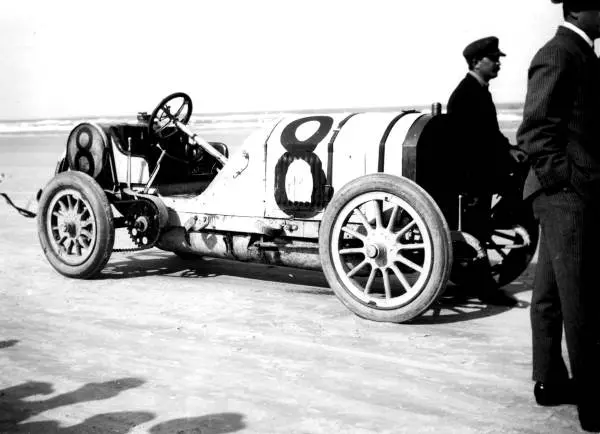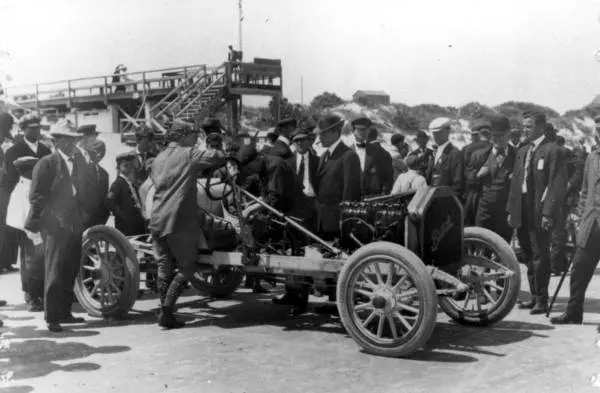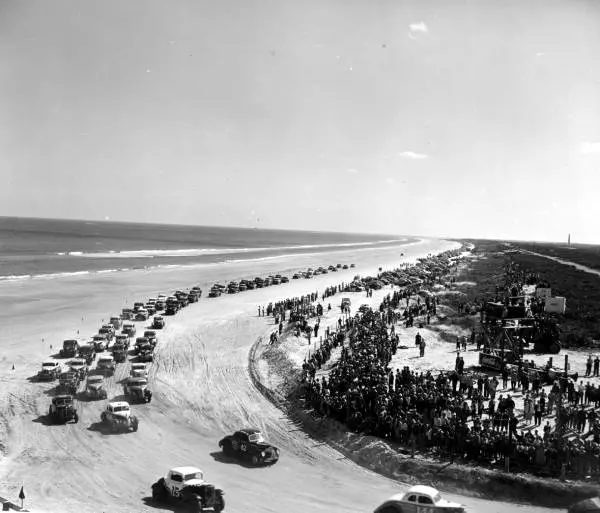Daytona is known around the world as a focal point of auto racing, with several important annual competitions held at Daytona International Speedway. The history of racing in the area goes back to the early twentieth century, when auto races were held on the firm sands of Daytona Beach and Ormond Beach.
When racing competitions started on the beach in 1903, cars were a luxury item that only very wealthy people could afford.
“The automobile had been around, but the problem was, it was just a play toy for the rich,” says Daytona historian Leonard Lempel. “It’s really not until 1913, 1914, when Henry Ford invented the long assembly line, the price of the automobile dropped dramatically, and by the 1920s, it was the car of the middle class. In 1903, when racing started here on the beach, wealthy northerners came down and stayed at Ormond Hotel. They took their cars out on the beach, and started racing.”
Ransom E. Olds, founder of Oldsmobile and the REO Motor Car Company, and Alexander Winston, founder of the Winston Motor Car Company, organized racing on the adjacent beaches at Ormond and Daytona. Racing quickly grew from an amusing pastime for the rich, to a popular sport enjoyed by people from every economic background. People came from around the world to race on the hard packed sand.
“There were two periods of racing between 1903 and 1958,” says Eric Breitenbach, director and producer of the documentary “Hoppin’ Rattlesnakes: Oral Histories of Beach Racing in Volusia County, 1903-1958.” “There were the speed trials that started in 1903, those were fascinating. The beach was very wide and long, it was 500 feet wide at that time and 27 miles long, and it was completely flat. So it was possible to race a car at a high rate of speed on that beach.”
There was a rivalry between British and American drivers in the first several decades of the twentieth century. The final land speed record set in Daytona was 276.82 miles per hour by British racer Sir Malcolm Campbell in 1935. That same year, the speed trials moved from the beaches of Daytona and Ormond to the salt flats of Bonneville, Utah. Campbell broke his own record there, becoming the first person to drive over 300 miles per hour.
“The second part of the history was the stock car racing, which included oval racing, a version of the speed trial, the measured mile speed trial, and even things like barrel racing,” says Breitenbach. “Then of course NASCAR formed as part of that stock car era.”
Bill France, Sr. founded the National Association for Stock Car Auto Racing in 1948, in Daytona.
Stock car racing continued on the beach until 1958. In 1959, NASCAR races moved to the newly constructed Daytona International Speedway, where the Daytona 500 has been held ever since.
Preston Root is known as “The Voice of NASCAR” for Motor Racing Network Radio, and participated in the making of the documentary film “Hoppin’ Rattlesnakes: Oral Histories of Beach Racing in Volusia County, 1903-1958.”
“I think the name of our movie ‘Hoppin’ Rattlesnakes’ is really one of the most interesting stories about all of beach racing in the (19)30s until the ‘50s,” says Root. “Florida was an unsettled state. This is very early on in our tourism history , and where this track was, and where tens of thousands of people assembled to see stock cars race on the beach, and part on A-1A, is unsettled Florida. There’s actually rattlesnakes living in the dunes. Longtime Floridians know there’s still plenty of rattlesnakes in Florida. They haven’t been at the beach in a while, but fans actually had to get past rattlesnakes in the dunes to get into the race track. The promoters at the time weren’t beyond warning people to not sneak into the track through the sand dunes where the rattlesnakes were. These signs that said ‘warning, rattlesnakes in dunes’ kept people from sneaking into the track and they’d have to buy their ticket and sit in the grandstands.”
The documentary film “Hoppin’ Rattlesnakes: Oral Histories of Beach Racing in Volusia County, 1903-1958” can be seen at the Halifax Historical Museum in Daytona.


